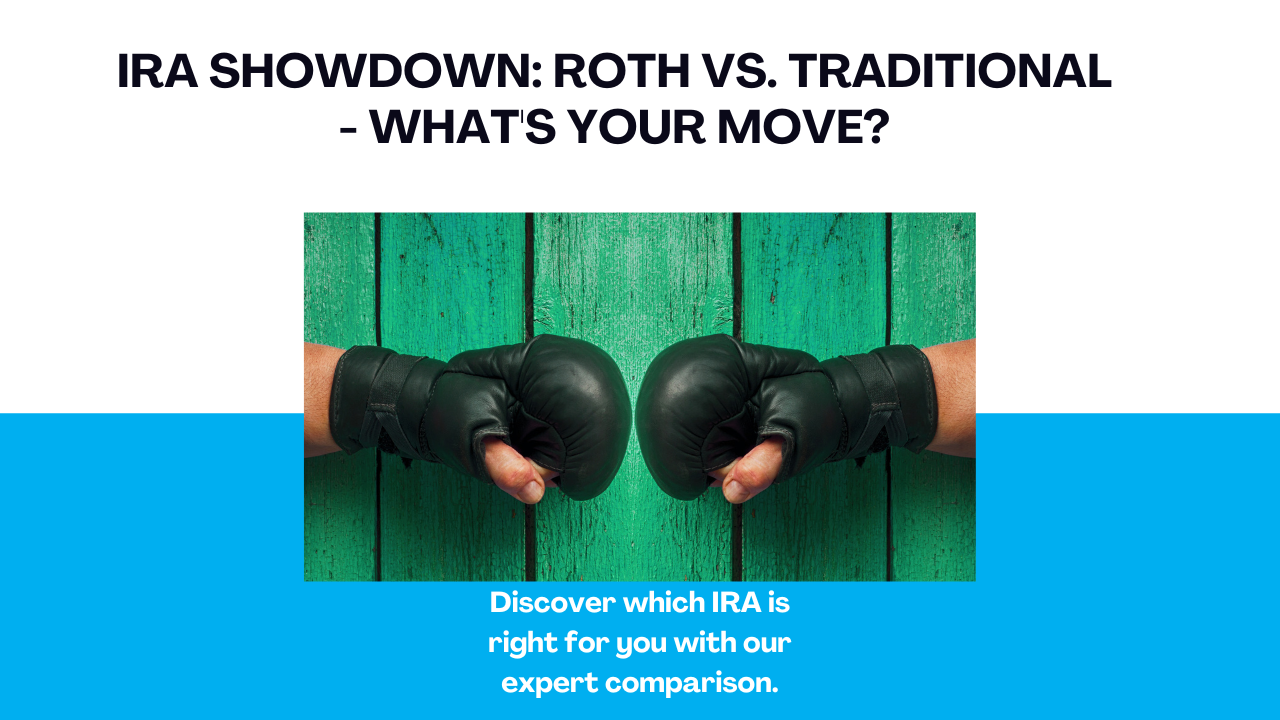I want to help you simplify the IRA dilemma that’s on everyone’s mind. Roth or traditional. I’ll help you make an informed choice for a secure retirement. Stay with us and get one step closer to a smarter retirement plan. Individual retirement accounts or IRAs are tax advantaged accounts designed to help you save for retirement. The two most common types are Roth IRAs and traditional IRAs, each with its own unique set of rules and tax benefits. Making an informed decision between the two can optimize the growth of your savings and potentially save you thousands of dollars over time. In today’s video, we’ll explore the key differences between Roth and traditional IRAs, weigh the pros and cons, and help you determine which option aligns with your financial goals and circumstances. We’ll also cover some real life scenarios to provide a closer picture of how each type of IRA might perform over time.
We have a lot to cover. So let’s get started by understanding the core differences between Roth and traditional IRAs. And don’t forget, I provided a link to a free handy flow chart in the description below to help walk you through the decision-making process. I think you’ll find it super helpful. Now let’s dive in. Let’s start by talking about the tax treatment of each. The traditional IRA contributions are made with pre-tax dollars, potentially lowering your tax bill now, but you’re going to have to pay income taxes on withdrawals and retirement. With the Roth IRA contributions are made with after tax dollars, no immediate tax break, but withdrawals in retirement are tax free, including the earnings, which is the really powerful part of the Roth. There are different income limits for each traditional IRA. You have no income limits for contributions, but tax deductibility may be phased out based on income and retirement plan coverage at work.
And when we talk about the retirement plan coverage at work, that really means if you are not covered by a workplace retirement plan, then you are able to make deductible contributions to the traditional IRA. Even if you do go over the limits. Now with the Roth IRA, there are income eligibility requirements and higher earners may be phased out from contributing directly. Here are some withdrawal rules. Traditional IRA withdrawals can start at age 59 and a half without penalties, with required minimum distribution starting at age 73, and that becomes an important point later on. The Roth IRA. There’s no RMDs during your lifetime. This provides more flexibility for withdrawals and estate planning, especially some of the pros for a traditional IRA are the immediate tax deductions, the tax deferred growth and no income limits for contributions. The cons, you’re going to have to pay taxes when you the money and required minimum distributions, you’ll have to take and pay taxes on whether you need the money or not.
For the Roth IRA, some of the pros are tax-free withdrawals, no RMDs, and the potential for tax-free growth, which is the real power in the Roth. Some negatives include the lack of an immediate tax deduction and the income limits for eligibility. So now that you know a bit more about each, how do you decide which one to choose? Well, here’s how the math works. If you think that your income tax rate in retirement will be lower than it is now, that would argue in favor of the traditional IRA. If you think your tax rate in retirement will be higher than it is now, it argues in favor of the Roth. Pretty simple, right? Well, here’s the thing. The conventional thinking on this in the past was based on the assumption that people would defer paying the taxes until retirement, at which point they would no longer be receiving paychecks.
Therefore, their income tax bracket would be lower. And that does make sense for some people, but there are some reasons besides the simple math that a Roth might make sense. In full disclosure, I have a bias towards tax-free growth, and when it does make sense, I tend to lean in that direction. One reason we might consider Roth is if we believe tax rates overall are going to be higher in the future. The fact is that our current tax rates are at 40 year lows and our national debt is over $30 trillion. We know that without congressional action, the tax Cut and Jobs Act or TCJA sunsets in 2025, at which point all of our taxes will be higher. We don’t know the future, but the threat of increased tax rates is definitely something to consider. Another reason, if you have a pension or another source of guaranteed income, you may not necessarily be in a lower tax bracket in retirement.
And the last point I’ll touch on, and there are more is called the widow or widowers penalty. So when a spouse passes away, the surviving spouse has to start filing as a single rather than a married filing jointly, which lowers the income threshold on the different tax brackets. This is the potential to propel the surviving spouse into a higher tax bracket. This is especially important for spouses when there’s a large age gap. These are just some points that make the Roth and compelling option, but it also highlights that there’s not a one size fits all solution because everyone’s situation and view toward the future is going to be different. Now, let’s look at a few scenarios involving some people within 10 years of retiring to help illustrate the impact of choosing the Roth versus the traditional. Let’s look at our first scenario. Having a lower income now and a higher income expected in retirement.
Meet Jake, he’s 50. He’s recently made a career change to launch a startup, although he’s currently in a lower tax bracket. He expects his business to thrive, propelling him into a higher tax bracket before retirement. Jake chooses a Roth, a valuing the tax-free withdrawals in retirement. Jake’s strategy is to take advantage of his current lower tax rate to make after tax contributions to a Roth A. This way he can enjoy tax-free withdrawals and earnings once he retires, especially beneficial if his tax rate is higher at that time. Next, we have a higher income now and a lower income expected in retirement. Meet Emily, she’s 68, a higher earning executive expecting to step down to a part-time role soon. This’ll place her in a lower tax bracket. She opts for a traditional IRA to lower her taxable income. Now while she’s still in a higher tax bracket.
Emily’s strategy works well for individuals expecting to have a lower income in retirement. The tax deductions now can be a significant advantage and she’ll likely pay taxes at a lower rate on her withdrawals in the retirement. Scenario. Number three, a high income earner with limited Roth access. Meet Liam, he’s 60 and his high income disqualifies him from contributing to a Roth a directly, however he values tax-free withdrawals in retirement. Liam utilizes a backdoor, a conversion to contribute to a traditional and then convert it to a, this backdoor strategy allows Liam to bypass income restrictions, positioning him to enjoy the benefits of a Roth A. It’s a savvy strategy for higher earners nearing retirement, although it’s crucial to consult with a tax professional due to the complex tax implications involved in deploying this strategy. Here’s our fourth and last scenario, and this one’s my favorite. A retiree is seeking to minimize taxes and preserve wealth.
Lastly, meets Sophia. She’s 62 and she has a blend of traditional and Roth IRAs, which she’s been contributing to over the years. This diversified approach allows her to manage her tax burden efficiently. Sophia’s strategy showcases the benefit of a balanced approach. By having both types of IRAs, she can strategically withdraw from each account to manage her tax situation each year in retirement, providing her with flexibility in her retirement income strategy. These scenarios underscore the importance of aligning your IRA choice with your personal financial outlook, especially as retirement approaches, it’s always a wise move to consult with a financial advisor to tailor a strategy that meets your individual needs and long-term goals. So let’s address some frequently asked questions surrounding Roth and traditional IRAs. First, can I contribute to a Roth and traditional A in the same year? Yes, you can contribute to both types of IRAs in the same year, but the total contribution across both accounts cannot exceed the annual limit set by the IRS. What if my income is too high for a, I mentioned this in one of our scenarios, and if your income exceeds the limits for a Roth A, you might consider a backdoor Roth conversion where you can contribute to a traditional A and then convert it to a Roth. I can’t express enough how crucial it is that you consult with a tax professional to understand the implications and the rules surrounding the backdoor process. Can I access my money before retirement without
With a Roth IRA, you can withdraw your contributions but not your earnings at any time without penalties or taxes. For a traditional IRA, withdrawals before age 59 and a half may be subject to taxes and a 10% early withdrawal penalty. With some exceptions, it’s essential to plan carefully to avoid unexpected tax liabilities or penalties, especially when accessing funds before the standard retirement age. So another reason to talk to your tax professional before making any moves. What happens to my RA if I pass away? Both Roth and traditional IRAs have provisions for beneficiaries. Your account can be transferred to your spouse or other designated beneficiaries who will then have options for managing the inherited IRA. Estate Planning is a crucial aspect of managing your IRAs and it’s advisable to consult with a financial advisor to understand the implications of your beneficiaries. These are just a few of the common questions surrounding Roth and traditional IRAs. There’s a lot to consider when planning for retirement and every situation is unique. I hope you found this information helpful, and I’ll see you next time.


